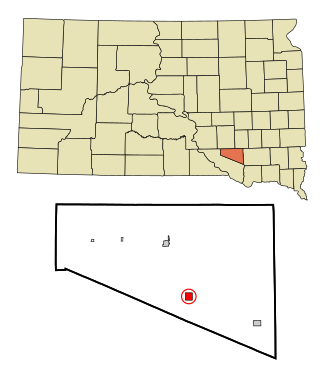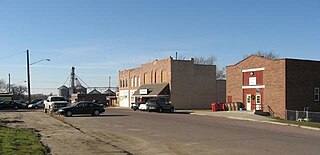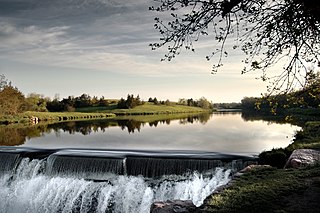Demographics
Historical population| Census | Pop. | Note | %± |
|---|
| 1890 | 514 | | — |
|---|
| 1900 | 519 | | 1.0% |
|---|
| 1910 | 901 | | 73.6% |
|---|
| 1920 | 1,105 | | 22.6% |
|---|
| 1930 | 1,312 | | 18.7% |
|---|
| 1940 | 1,500 | | 14.3% |
|---|
| 1950 | 1,430 | | −4.7% |
|---|
| 1960 | 1,442 | | 0.8% |
|---|
| 1970 | 1,495 | | 3.7% |
|---|
| 1980 | 1,590 | | 6.4% |
|---|
| 1990 | 1,394 | | −12.3% |
|---|
| 2000 | 1,328 | | −4.7% |
|---|
| 2010 | 1,241 | | −6.6% |
|---|
| 2020 | 1,215 | | −2.1% |
|---|
|
2010 census
As of the census [14] of 2010, there were 1,241 people, 574 households, and 313 families living in the city. The population density was 1,700.0 inhabitants per square mile (656.4/km2). There were 658 housing units at an average density of 901.4 per square mile (348.0/km2). The racial makeup of the city was 97.8% White, 0.5% African American, 0.7% Native American, 0.1% Asian, and 0.9% from two or more races. Hispanic or Latino of any race were 1.1% of the population.
There were 574 households, of which 23.0% had children under the age of 18 living with them, 44.6% were married couples living together, 6.1% had a female householder with no husband present, 3.8% had a male householder with no wife present, and 45.5% were non-families. 41.3% of all households were made up of individuals, and 21.7% had someone living alone who was 65 years of age or older. The average household size was 2.06 and the average family size was 2.79.
The median age in the city was 48.6 years. 20.1% of residents were under the age of 18; 6% were between the ages of 18 and 24; 18.7% were from 25 to 44; 27.7% were from 45 to 64; and 27.5% were 65 years of age or older. The gender makeup of the city was 48.7% male and 51.3% female.
2000 census
As of the census [5] of 2000, there were 1,328 people, 580 households, and 346 families living in the city. The population density was 1,893.5 inhabitants per square mile (731.1/km2). There were 667 housing units at an average density of 951.0 per square mile (367.2/km2). The racial makeup of the city was 97.82% White, 1.13% Native American, 0.15% Asian, 0.08% from other races, and 0.83% from two or more races. Hispanic or Latino of any race were 0.98% of the population.
There were 580 households, out of which 27.4% had children under the age of 18 living with them, 49.5% were married couples living together, 6.9% had a female householder with no husband present, and 40.2% were non-families. 37.4% of all households were made up of individuals, and 22.9% had someone living alone who was 65 years of age or older. The average household size was 2.18 and the average family size was 2.88.
In the city, the population was spread out, with 22.9% under the age of 18, 5.0% from 18 to 24, 23.2% from 25 to 44, 22.2% from 45 to 64, and 26.7% who were 65 years of age or older. The median age was 44 years. For every 100 females, there were 87.8 males. For every 100 females age 18 and over, there were 82.9 males.
As of 2000 the median income for a household in the city was $31,148, and the median income for a family was $37,639. Males had a median income of $29,931 versus $18,500 for females. The per capita income for the city was $18,327. About 5.7% of families and 8.7% of the population were below the poverty line, including 4.7% of those under age 18 and 16.2% of those age 65 or over.

Marshall County is a county in the U.S. state of South Dakota. As of the 2020 census, the population was 4,306. Its county seat is Britton. The county was created on May 2, 1885, and was named for Marshall Vincent, who homesteaded near Andover, South Dakota.

Tipton (/ˈtɪptən/) is a city in Cedar County, Iowa, United States. The population was 3,149 at the time of the 2020 census. It is the county seat of Cedar County.

Tyndall is a city in and the county seat of Bon Homme County, South Dakota, United States. The population was 1,057 at the 2020 census.

Groton is a city in southeastern Brown County, South Dakota, United States. The population was 1,380 at the 2020 census.

Chamberlain is a city in Brule County, South Dakota, United States. It is located on the east bank of the Missouri River, at the dammed section of the Lake Francis Case, close to where it is crossed by Interstate 90.

Armour is a city in county seat of Douglas County, South Dakota, United States. The population was 698 at the 2020 census.

Ipswich is a city in and county seat of Edmunds County, South Dakota, United States. The population was 928 at the 2020 census.

Gregory is a city in western Gregory County, South Dakota, United States. The population was 1,221 at the 2020 census.

Miller is a city in and county seat of Hand County, South Dakota, United States. The population was 1,349 at the 2020 census.

Parkston is a city in Hutchinson County, South Dakota, United States. The population was 1,567 at the 2020 census.

Murdo is a city in and the county seat of Jones County, South Dakota, United States. The population was 475 at the 2020 census.

Lennox is a city in Lincoln County, South Dakota, United States, located 20 miles (32 km) southwest of Sioux Falls. The population was 2,423 at the 2020 census.

Baltic is a city on the Big Sioux River in northern Minnehaha County, South Dakota, United States. The population was 1,246 at the 2020 census.

Crooks is a city in Minnehaha County, South Dakota, United States and is a suburb of Sioux Falls. The population was 1,362 at the 2020 census. Crooks was named New Hope until 1904. The town's present name honors W. A. Crooks, a local politician.

Garretson is a city in Minnehaha County, South Dakota, United States. The city had a population of 1,228 at the 2020 census.

Hartford is a suburban American city in Minnehaha County, South Dakota, a few miles northwest of Sioux Falls. Its population was 3,354 at the 2020 census.

Wilmot is a city in Roberts County, South Dakota, United States. The population was 432 at the 2020 census.

Woonsocket is a city in Sanborn County, South Dakota. The population was 631 at the 2020 census. It is the county seat of Sanborn County.

Redfield is a city in and the county seat of Spink County, South Dakota, United States. The population was 2,214 at the 2020 census. The city was named for J. B. Redfield, a railroad official.

Elk Point is a city in and the county seat of Union County, South Dakota, United States. The population was 2,149 as of the 2020 census.





















